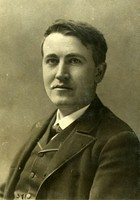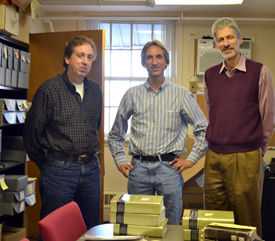Thomas Edison’s First Wife May Have Died of a Morphine Overdose
Thanks to New Digital Sources, Rutgers Scholars Uncover New Information Surrounding Mary Edison’s Death

When Louis Carlat and his colleagues at the Thomas Edison Papers, based at Rutgers University, began working on Volume 7 of the papers in 2006, they benefited from what Carlat calls “an explosion of available electronic and digital historical sources.”
Those online sources helped Carlat and his team uncover new information about Edison’s personal and professional life, including the intriguing possibility that his first wife, Mary Edison, died from a morphine overdose on August 9, 1884. 
“We were only able to find out as much about Mary’s death as we did by using those sources. We would never have been able to get this far otherwise,” said Carlat, managing editor of Volume 7, Losses and Loyalties: April 1883 – December 1884, just published by Johns Hopkins University Press.
The evidence is circumstantial, not direct. During the 1880s, Carlat explained, doctors administered morphine and other opiates often, and for all sorts of complaints, especially to young, middle- and upper-class women. Morphine was easily available without a prescription. “Just about every medical concoction you can think of in the 19th century had morphine or some sort of opiate in it,” said Paul Israel, director of the Thomas Edison Papers.
The researchers started with a "snippet," excerpted from an unidentified newspaper, which said that Edison had tried to revive his comatose wife with electric shocks. Using proprietary databases such as NewspaperArchive.com, researcher Scott Bruton traced this fragmentary claim to a much longer unsigned article that included allegations that Mary Edison had been a longtime morphine user and had died of an overdose.
“At that point the story crossed with another line of research based on a rare interview Mary had recently given to the same paper that we found – of course – online,” Carlat said. “We surmised that the interviewer was likely the author of the death article, which gave the story some credibility.”
The researchers then tried to learn all they could about morphine. They made heavy use of Google Books, which functioned for them as a huge subject catalog. “Otherwise, you spend half your time just figuring out which books you’re most likely interested in,” Carlat said. They read about “congestion of the brain,” a broad description with many possible causes that was given as the official cause of Mary Edison’s death.
“It turns out that doctors considered congestion of the brain to be a physical symptom of opiate overdose, and at least one medical text prescribed electric shock as a way to revive victims, just as Edison reportedly tried,” Carlat said. 
The researchers were unable to confirm this version of events, but they at least had a plausible story that fit the timeline of events. In 1884, Thomas Edison's world was changing rapidly. Financing for his electric light system was drying up and he was planning to cut his losses and get out of the business altogether. And then Mary died, leaving Edison with three young children (ages 8 to 12), no real job, and no clue about what to do next. He had to borrow $500 to bury his wife.
By the end of 1884, Edison had begun to recover from his financial and psychological troubles, Carlat said. The Thomas Edison Papers team is already working on Volume 8, which covers 1885 to 1887, and tentatively titled, “New Beginnings.”
It depicts Edison’s life as he settles his business problems, returns to the laboratory, meets and marries Mina Edison, his second wife, and starts a second family.
To learn more about Thomas Edison and the work of the Thomas Edison Papers, see this Rutgers Magazine article, In Search of Thomas Edison